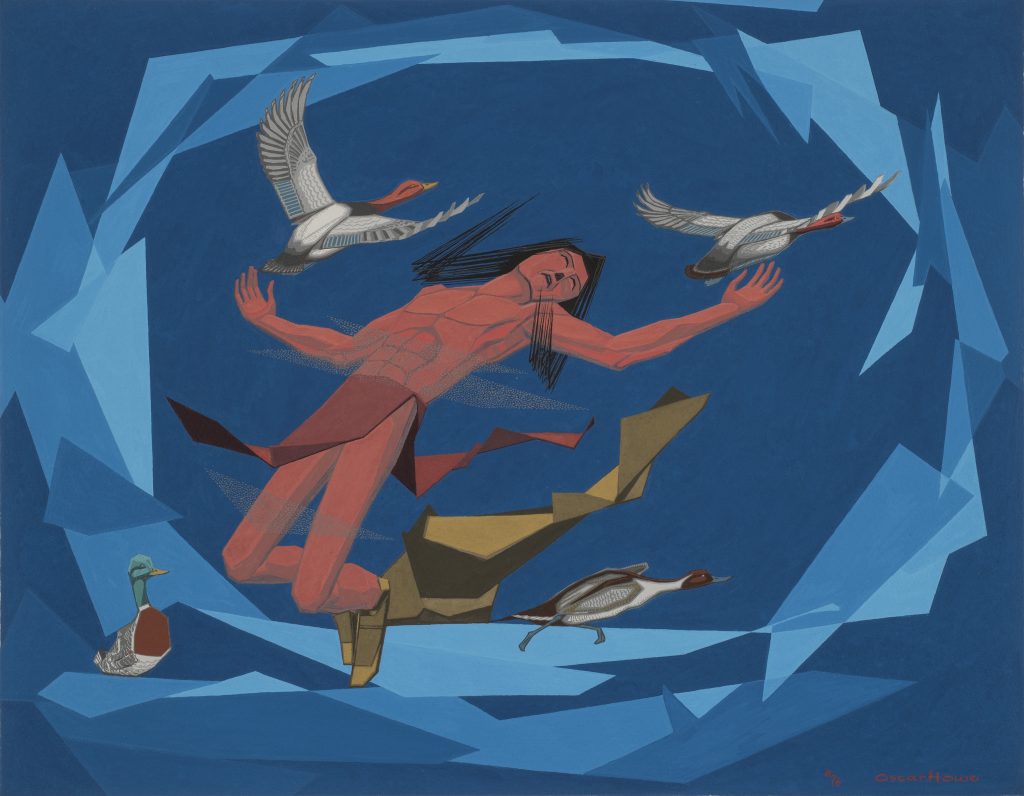
“Traditional ecological knowledge is a cumulative body of knowledge and beliefs, handed down through generations by cultural transmission, about the relationship of living beings (including humans) with one another and with their environment….”- Fikret Berkes
Overview and Context
This lesson helps students (8th grade and up) learn about the removal of Indigenous people from their land became a federal policy with the passage of the Indian Removal Act in 1830; it is part of a larger unit on the Removal Act. The process of removal created upheaval, suffering, and death among Indian people. However, they have survived and thrive as their own culture today.
One way the culture and history has been kept alive has been through stories and art. Oscar Howe was an artist who greatly contributed to recording this painful past while refusing to be limited to traditional art. Although this particular lesson focuses on Oscar Howe, this approach and these materials could be applied to another indigenous artist, perhaps one local to your area.
Related California History Standards
- 8.8 Students analyze the divergent paths of the American people in the West from 1800 to the mid-1800s and the challenges they faced.
- 2.Describe the purpose, challenges, and economic incentives associated with westward expansion, including the concept of Manifest Destiny (e.g., the Lewis and Clark expedition, accounts of the removal of Indians, the Cherokees’ “Trail of Tears,” settlement of the Great Plains) and the territorial acquisitions that spanned numerous decades.
Learning Objectives
Through the biography and art of Oscar Howe, students will begin to explore the importance of Native lands, lasting effects of Indian Removal policy on Indigenous people, and how art and poetry can be used to maintain and rebuild connections to land and culture.
Assessment
Students will write their own poetry and will then use their descriptions to create a watercolor painting using the colors, and shapes of the land.
Materials
- Slide show of Oscar Howe’s life and art; “I am From” poetry outline; watercolor paints and paper.
- Save the Salmon TEK Curriculum
- Poem Template (see below); also see “I Am From” Poem and “Where I’m From” Poem
- Rick Bartow Bear Dancer Image
- Rick Bartow Mask Image
- Dakota Modern Oscar Howe Image
- Oscar Howe Modern Dakota Fighting Bucks Image
- Oscar Howe Modern Dakota Sun Dance Image
- Oscar Howe Mazuha Hokshina Image
- Oscar Howe Oktomi and Ducks 2 Image
Preparation
This is a continued lesson about the Indian Removal Act. This lesson should take students to more of a feeling place to try to understand more deeply what it means to be connected to the land.
Step-by-Step Instructional Plan
1. Review and Reflection
Teacher will begin by reading Land Acknowledgement and reviewing the previous day’s lesson about Andrew Jackson and the Indian Removal Act.
Next, teacher will ask students to do the following:
- Close your eyes and think of a special place you have gone outside, out in nature.
- Imagine the sounds, the colors, the shapes.
- Open your eyes and write some adjectives that come to mind that would describe this place. Just a list, try to be as descriptive as possible.
Next, the teacher will ask a volunteer to read these quotes out loud:
The earth does not belong to man, man belongs to the earth. All things are connected like the blood that unites one family. Man did not weave the web of life, he is merely a strand in it. Whatever he does to the web, he does to himself. The earth is sacred and men and animals are but one part of it. Treat the earth with respect so that it lasts for centuries to come and is a place of wonder and beauty for our children.”― Excerpt from Chief Seattle
It is important to acknowledge the difference between western and Indigenous worldviews, particularly how they refer to and engage with Land and natural resources. Settler colonialism has attempted to separate humans from their environment by trying to convince us that we are somehow better or more sophisticated than plants, animals, rivers, or other natural resources. We have therefore been taught that it is our right to manage the Land as we see fit, and to harness its benefits for our own use, while neglecting the needs of entire ecosystems. Alternatively, Indigenous Peoples believe it is their responsibility to care for the Lands and Waters, and to maintain balance and reciprocity in order to ensure the health of the world as a whole.” ― Save the Salmon
2. Introduction to Oscar Howe
Share the Slideshow presentation and read the poetry resources – “I Am From” Poem and “Where I’m From” Poem – together.
3. Writing the Poem
The instructor can use the poem template (below) and guide students through writing their own poems.
Name:
I am from (a specific item from your childhood home)
from (two objects from your past)
I am from (a phrase describing your childhood home)
And (more description of your childhood home)
I am from (a plant or tree near where you live)
Whose (personify that natural object)
I am from (two natural landmarks near where you live)
from (two colors or shapes of the land where you live)
And from (two family celebrations and/or traditions)
from (describe the seasons of these celebrations)
I am from (your heritage)
from (two foods from your family history)
from (a specific event in the life of an ancestor)
I am from (what you love most about where you live)
Related Resources
- The Art of Oscar Howe, National Museum of the American Indian
- The Indian Removal Act, Library of Congress
- Oscar Howe biography, South Dakota State University


